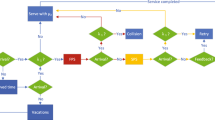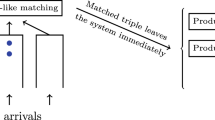Abstract
In this paper, a stochastic model of a call center with a two-level architecture is analyzed. A first-level pool of operators answers calls, identifies, and handles non-urgent calls. A call classified as urgent has to be transferred to specialized operators at the second level. When the operators of the second level are all busy, the operator of first-level handling the urgent call is blocked until an operator at the second level is available. Under a scaling assumption, the evolution of the number of urgent calls blocked at level 1 is investigated. It is shown that if the ratio of the number of operators at level 2 and 1 is greater than some threshold, then, essentially, the system operates without congestion, with probability close to 1 no urgent call is blocked after some finite time. Otherwise, we prove that a positive fraction of the operators of the first level is blocked due to the congestion of the second level. Stochastic calculus with Poisson processes, coupling arguments and formulations in terms of Skorokhod problems are the main mathematical tools to establish these convergence results.


Similar content being viewed by others
References
Allamigeon, X., Bœuf, V., Gaubert, S.: Performance evaluation of an emergency call center: tropical polynomial systems applied to timed Petri nets, FORMATS’15. Lecture Notes in Computer Science, vol. 9268. Springer (2015)
Allamigeon, X., Bœuf, V., Gaubert, S.: Stationary solutions of discrete and continuous Petri nets with priorities. Perform. Eval. 113, 1–12 (2017)
Anderson, R.F., Orey, S.: Small random perturbation of dynamical systems with reflecting boundary. Nagoya Math. J. 60, 189–216 (1976)
Balsamo, S.: Queueing Networks with Blocking: Analysis, Solution Algorithms and Properties, pp. 233–257. Springer, Berlin (2011)
Best, E., Wimmel, H.: Structure Theory of Petri Nets, Transactions on Petri Nets and Other Models of Concurrency VII, pp. 162–224. Springer, Berlin (2013)
Bhulai, S., Koole, G.: A queueing model for call blending in call centers. IEEE Trans. Autom. Control 48(8), 1434–1438 (2003)
Billingsley, P.: Convergence of Probability Measures. Wiley Series in Probability and Statistics: Probability and Statistics. Wiley, New York (1999)
Chen, H., Mandelbaum, A.: Discrete flow networks: bottleneck analysis and fluid approximations. Math. Oper. Res. 16(2), 408–446 (1991)
Cohen, G., Gaubert, S., Quadrat, J.-P.: Asymptotic throughput of continuous timed Petri nets. In: 34th Conference on Decision and Control (New Orleans) (1995)
Dong, J., Perry, O.: Queueing models for patient-flow dynamics in inpatient wards. Available at SSRN 3246641 (2018)
El Karoui, N., Chaleyat-Maurel, M.: Temps locaux, vol. 52–53, ch. Un problème de réflexion et ses applications au tempslocal et aux équations différentielles stochastiques sur \({{\mathbb{R}}}\), pp. 117–144, Société Mathématique de France,1978, Exposés du Séminaire J. Azéma-M. Yor, Paris (1976–1977)
Harrison, J.M., Reiman, M.I.: Reflected Brownian motion on an orthant. Ann. Probab. 9(2), 302–308 (1981)
Kelly, F.P.: Reversibility and Stochastic Networks. Wiley Series in Probability and Mathematical Statistics. Wiley, Chichester (1979)
Kelly, F.P.: Blocking probabilities in large circuit-switched networks. Adv. Appl. Probab. 18, 473–505 (1986)
Kingman, J.F.C.: Poisson Processes, Oxford studies in probability. Oxford Science Publications, The Clarendon Press, Oxford University Press, New York (1993)
Koole, G., Mandelbaum, A.: Queueing models of call centers: an introduction. Ann. Oper. Res. 113(1), 41–59 (2002)
Liggett, T.M.: Ergodic theorems for the asymmetric simple exclusion process. Trans. Am. Math. Soc. 213, 237–261 (1975)
Liggett, T.M.: Interacting Particle Systems. Grundlehrender mathematischen Wissenschaften. Springer, New York (1985)
Murata, T.: Petri nets: properties, analysis and applications. Proc. IEEE 77(4), 541–580 (1989)
Pang, G., Perry, O.: A logarithmic safety staffing rule for contact centers with call blending. Manag. Sci. 61(1), 73–91 (2015)
Robert, P.: Stochastic Networks and Queues, Stochastic Modelling and Applied Probability Series, vol. 52. Springer, New York (2003)
Skorokhod, A.V.: Stochastic equations for diffusion processes in a bounded region. Theory Probab. Appl. 7, 3–23 (1962)
Watanabe, S.: On discontinuous additive functionals and Lévy measures of a Markov process. Jpn. J. Math. 34, 53–70 (1964)
Yang, R., Bhulai, S., Van der Mei, R.: Optimal resource allocation for multiqueue systems with a shared server pool. Queueing Syst. 68(2), 133–163 (2011)
Author information
Authors and Affiliations
Corresponding author
Additional information
Publisher's Note
Springer Nature remains neutral with regard to jurisdictional claims in published maps and institutional affiliations.
Rights and permissions
About this article
Cite this article
Bœuf, V., Robert, P. A stochastic analysis of a network with two levels of service. Queueing Syst 92, 203–232 (2019). https://doi.org/10.1007/s11134-019-09617-y
Received:
Revised:
Published:
Issue Date:
DOI: https://doi.org/10.1007/s11134-019-09617-y




